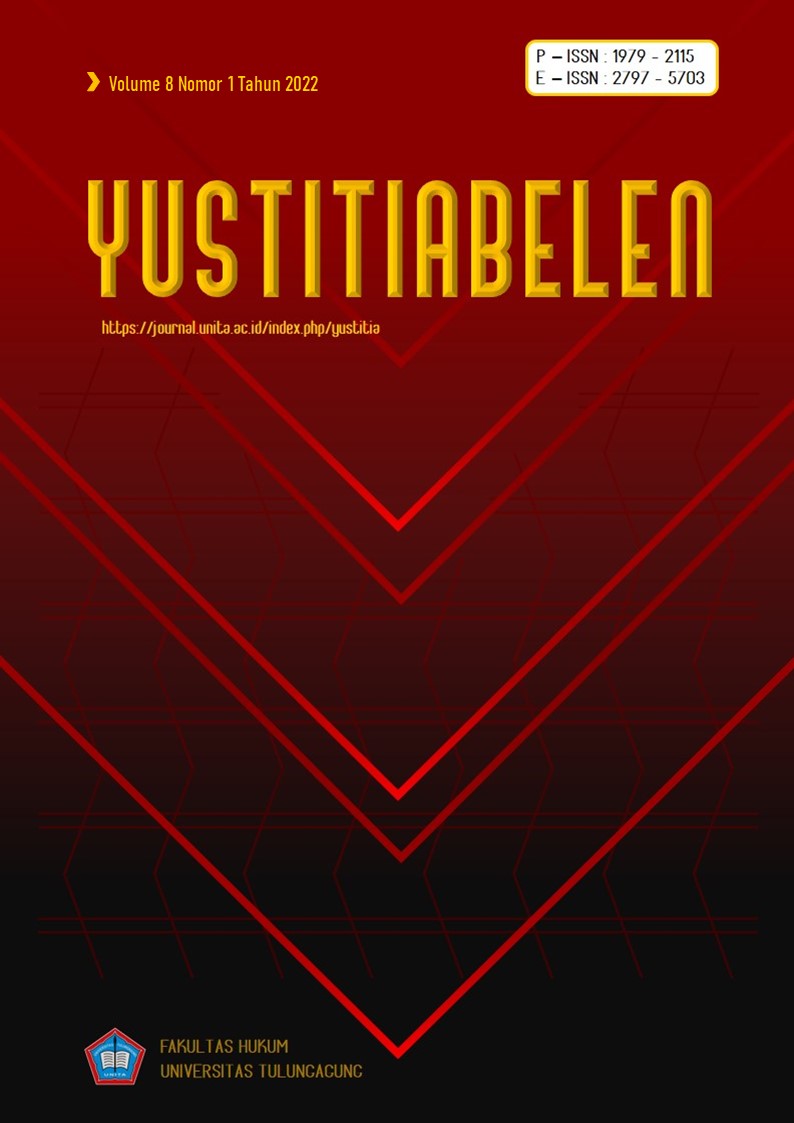Fondasi Ecological-Philosophy dengan Model Place-Based Education untuk Clinical Legal Education
DOI:
https://doi.org/10.36563/yustitiabelen.v8i1.491Keywords:
Clinical Legal Education, Place-Based Education, Ecosophy, Deep EcologyAbstract
Human misdeeds and the absence of legislative acknowledgement of environmental integrity cause environmental devastation. Historically, anthropocentric views of law have resulted in laws that serve as instruments to tame and manage nature, with nature existing solely as a means to an end: human welfare (in terms of human rights). As a legal instrument, it might be considered a natural legitimacy that destroys the environment, particularly via anthropocentric power relations. Environmental law is still biased in favor of human wellbeing rather than ecological integrity. As a result of this study, it is
necessary to design an extra learning model for Clinical Legal Education (CLE) based on the Ecological Philosophy paradigm that supports the Deep Ecology perspective with the Pedagogy of Place-Based Education (PBE) Model. This study uses a qualitative descriptive-analytical approach to highlight the situation and legal requirements. The outcomes of this study indicate that the prevalence of the anthropocentric paradigm in law results in clinical legal education that is similarly anthropocentrically constrained. Connectivity while activity exists solely between humans. Therefore, CLE requires one more model to be liberated. The PBE paradigm successfully connects humans with their ecological surroundings. This relationship must adhere to the ecological paradigm. Therefore, the ecological philosophy foundation supplied can enhance students' environmental consciousness. So that in clinical legal education activities, students are ecologically aware and may encourage access to environmental justice.
Downloads
References
Aiken, J. H. (2000). Provocateurs for justice. Clinical L. Rev., 7, 287.
Asshiddiqie, J. (2010). Green Constitution; Nuansa Hijau Undang-Undang Dasar Republik Indonesia tahun 1945. Jakarta. Rajawali Press.
Borrows, J. (2016). Outsider education: Indigenous law and land-based learning. Windsor YB ACCEss Just., 33, 1.
Dubin, J. C. (1997). Clinical Design for Social Justice Imperatives. SMUL Rev., 51, 1461.
Gruenewald, D. A. (2003). The best of both worlds: A critical pedagogy of place. Educational Researcher, 32(4), 3–12.
Keraf, S. (2010). Etika Lingkungan Hidup, Penerbit Buku Kompas. Jakarta.
Madhloom, O., & McFaul, H. (2021). Thinking about Clinical Legal Education: Philosophical and Theoretical Perspectives. Routledge.
Mertz, E. (2007). The language of law school: learning to" think like a lawyer". Oxford University Press, USA.
Naess, A. (1973). The shallow and the deep, long‐range ecology movement. A summary. Inquiry, 16(1–4), 95–100.
Naess, A. (1989). From ecology to ecosophy, from science to wisdom. World Futures: Journal of General Evolution, 27(2–4), 185–190.
Naess, A. (1990). Ecology, community and lifestyle: outline of an ecosophy. Cambridge university press.
Naess, A. (1995). Self-realization. An ecological approach to being in the world. G. Sessions (Ed.), Deep Ecology for the Twenty-First Century, Boston and London (Shambhala) 1995, Pp. 225-239.
Naess, A. (2009). The ecology of wisdom: Writings by Arne Naess. Catapult.
Næss, A., & Jickling, B. (2000). Deep ecology and education: A conversation with Arne Naess. Canadian Journal of Environmental Education (CJEE), 5(1), 48–62.
Pincus, W. (1969). Educational Values in Clinical Experience for Law Students. Clinical Education for Law Students: Essays by William Pincus.
Rahardjo, S. (2008). Hukum Untuk Manusia, Bukan Manusia Untuk Hukum. Jurnal Ultimatum.
Rowe, W. V. (1916). Legal clinics and better trained lawyers a necessity. Ill. LR, 11, 591.
Sarker, S. P. (2016). Clinical legal Education in Asia: Accessing justice for the underprivileged. Springer.
Smith, G. A. (2002). Place-based education: Learning to be where we are. Phi Delta Kappan, 83(8), 584–594.
Sobel, D. (2004). Place-based education: Connecting classroom and community. Nature and Listening, 4(1), 1–7.
Sohn, L. B. (1973). Stockholm declaration on the human environment, the. Harv. Int’l. LJ, 14, 423.
Usman, A. S. (2018). Lingkungan Hidup Sebagai Subjek Hukum: Redefinisi Relasi Hak Asasi Manusia Dan Hak Asasi Lingkungan Hidup Dalam Perspektif Negara Hukum. Jurnal Ilmiah Hukum LEGALITY, 26(1), 1. https://doi.org/10.22219/jihl.v26i1.6610
Downloads
Published
Issue
Section
License
1. Hak cipta atas artikel apa pun dipegang oleh penulisnya.
2. Penulis memberikan jurnal, hak publikasi pertama dengan karya yang dilisensikan secara bersamaan di bawah Lisensi Atribusi Creative Commons yang memungkinkan orang lain untuk membagikan karya dengan pengakuan atas kepenulisan dan publikasi awal karya tersebut dalam jurnal ini.
3. Penulis dapat membuat pengaturan kontrak tambahan yang terpisah untuk distribusi non-eksklusif dari versi jurnal yang diterbitkan dari karya tersebut (misalnya, mempostingnya ke repositori institusional atau menerbitkannya dalam sebuah buku), dengan pengakuan dari publikasi awalnya di jurnal ini.
4. Penulis diizinkan dan didorong untuk memposting karya mereka secara online (misalnya, di repositori institusional atau di situs web mereka) sebelum dan selama proses pengiriman, karena hal itu dapat mengarah pada pertukaran yang produktif, serta kutipan yang lebih awal dan lebih besar dari karya yang diterbitkan.
5. Artikel dan materi terkait yang diterbitkan didistribusikan di bawah Lisensi Internasional Creative Commons Attribution-ShareAlike 4.0












